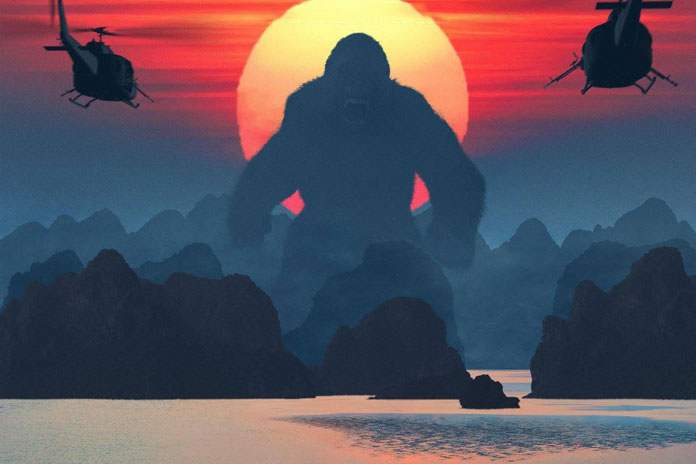2014’s Hollywood-made Godzilla movie reboot proved divisive among some monster movie fans, but the movie clearly did well enough with critics and the box office to lay the foundation for follow-ups. As we continue to await that movie’s direct sequel however, which has currently been pushed all the way back to 2019, we instead get to indulge in another surprising piece of Warner Bros.’ new ‘MonsterVerse’, this time from a property on loan from competitor, Universal; King Kong.
2005 saw a pretty enjoyable, well-made remake of the original iconic King Kong movie of 1933, from Lord of the Rings and Hobbit trilogy director, Peter Jackson, but in the latest return to the big screen by the King of the Apes, Kong: Skull Island is doing away with Kong’s classic origin story. Instead, Kong: Skull Island moves the setting up to 1973, and sets almost the entire production on the titular Skull Island, in turn making it a loose prequel to 2014’s Godzilla with an entirely different cast, though one that still fills in a key backstory related to the Project Monarch initiative from Godzilla.
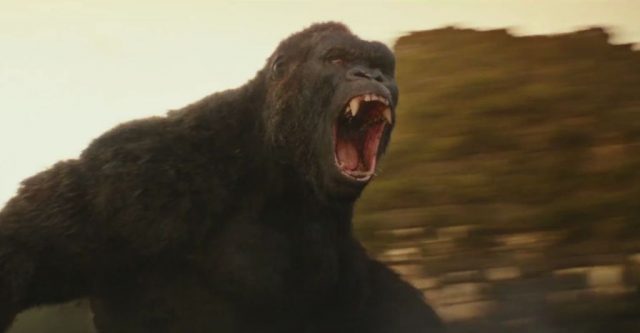
As for how Kong: Skull Island stacks up against Godzilla in terms of quality though, it’s a bit of a tricky question. Godzilla is undeniably the more clever and inspired movie, but Kong: Skull Island compensates by generally feeling more entertaining and satisfying to enjoy as a popcorn blockbuster for the busy March month. Kong himself is also a huge draw, as the titular ape steals the show every time he’s on screen, which, like Godzilla before him, doesn’t feel nearly often enough.
Kong: Skull Island has some flaws in the writing and direction, and as with too many monster movies, you won’t care about most of the human cast at all in the end, despite some enjoyable performances from the prestigious selection of high-profile lead actors. If you’re going for Kong himself, and just want to enjoy a dangerous island full of massive beasts that eat and crush a lot of folks, then Kong: Skull Island is an entertaining, if slightly disposable blockbuster. This movie falls considerably beneath the most well-known King Kong movies from 1933 and 2005, but it’s certainly not the worst Kong appearance on the big screen at all, and at least carves out its own competent niche in Kong’s cinematic legacy.
Kong: Skull Island has one of the most impressive casts assembled in any 2017 blockbuster at this point. John Goodman, Samuel L. Jackson, Brie Larson, Tom Hiddleston, Toby Kebbell, Corey Hawkins, John C. Reilly and more headline a surprisingly impeccable set of leads, which is why it’s unfortunate that the writing doesn’t service any of their characters very much. Some get a worse deal than others, mind you. Goodman’s entire character is a conspiracy nut trying to convince the world that monsters exist, Larson’s entire character is a photographer who is sick of war, and Hiddleston’s character is the badass guide that mostly exists to be in charge. There’s not much else to their characters beyond that, even though all of their performances are naturally pretty solid. Likewise, Hawkins and Kebbell barely contribute anything to the plot, with Kebbell’s character in particular only existing to create a transparent plot extension for later, and Hawkins’ character seemingly only existing to provide a link to Skull Island for Monarch in future MonsterVerse movies.
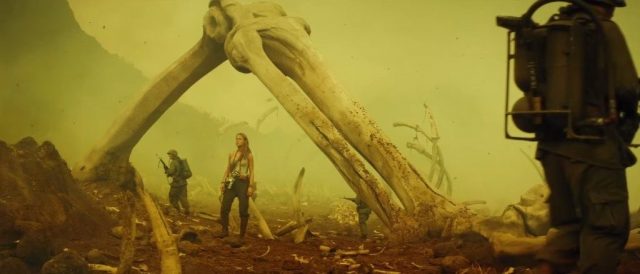
Slightly better off are Jackson and Reilly, who are probably the most memorable personalities in the bunch here. Jackson’s psychologically bruised war machine is a cocky soldier boy that you will love to hate, even if the movie’s attempts to make him the loose cannon antagonist to Kong feel almost laughable, considering how ill-equipped Jackson’s Vietnam vet really is in terms of actually fighting the now-much bigger and more dangerous King of the Apes. Reilly, on the other hand, being a WWII soldier that’s been stuck on Skull Island for nearly three decades, is saddled with being the movie’s comic relief, which he does a reasonably good job at, despite the occasional tonal confusion that this can create. So much of Kong: Skull Island’s titular setting is brutal and violent, so suddenly having Reilly crack dumb jokes about the island’s seemingly unstoppable and highly vicious monsters can create some pretty big tonal whiplash, but Reilly never goes so far as to become annoying, at the very least. As I said, the attempts to create levity in an impossibly grim situation do at least make his character more memorable too.
As you can imagine though, it’s Kong that serves as the big draw of the movie, with Kong portrayed very effectively by motion-capture actor, Terry Notary, whom you might remember as Rocket from the duo of recent Planet of the Apes prequels/reboots from 20th Century Fox. Kong himself is very impressive in this movie, and steals the movie whenever he’s on screen. Being a good balance between gentle intelligence and animalistic rage, Kong begins the movie as a frightening beast that you can sympathize with the desire to destroy, but when Kong proves to be possibly the least dangerous monster on Skull Island, it becomes easier to see him as something else entirely. The way that Kong: Skull Island builds Kong up as an anti-hero is generally done really well, even if he’s definitely at his best when you just get to watch him destroy helicopters and rip apart other monsters.
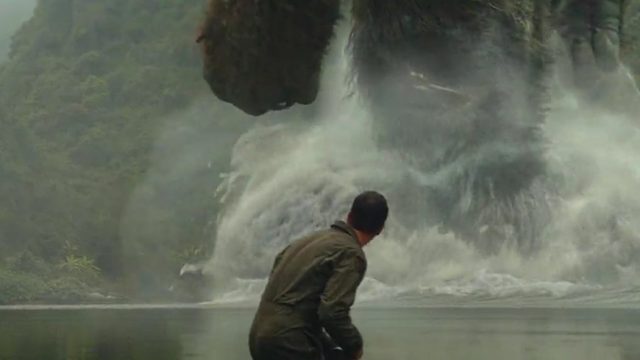
The human characters however, by contrast, feel like cardboard cutouts when stacked against the more cool and imposing likes of Kong, and you probably won’t even remember their names by the time you exit the theatre. That’s also before considering that most anyone that isn’t a lead actor on Skull Island pretty much only exists to be a redshirt for various monsters to murder. One could thus have two schools of thought about this result, the first being that Kong: Skull Island feels like style-over-substance when compared to many other King Kong movies, and is thus disappointingly shallow, and the second being that this is a monster movie, so going for the human characters means that you don’t have your priorities straight. Regardless of which school of thought you subscribe to, no one is bad or irritating, on the bright side, they’re just often very bland, which does undeniably feel like a considerable waste of so many fantastic lead actors.
Another potential issue with Kong: Skull Island is the fact that its story structure is kind of a mess, and this leads to some really weird pacing in some spots. Again, you could subscribe to the school of thought that dictates the human characters not truly mattering in a monster movie, but that doesn’t change the fact that we’re spending most of the movie with the humans, while Kong is relegated to certain select scenes. We at least get to see Kong throw down with other monsters significantly more often than Godzilla did in his own 2014 Hollywood reboot, but Kong still doesn’t have that much screentime in the end.

Kong: Skull Island tries to go for something of a Vietnam War-inspired feel, which is unsurprising, considering its 1973 setting, but the humans are so completely outmatched by the monsters that it never feels like a truly fair fight in the majority of scenes. Thus, Kong: Skull Island instead tries to pivot to be a survival thriller once everyone is properly stuck on Skull Island, which works well enough, until it has to start providing some really ham-fisted excuses to keep characters on the island for as long as possible, even when they have a straightforward avenue of escape. Some of this contrivance stinks a little of script rewrites, especially when it was decided after the movie’s conception to place it in Warner Bros.’ care, and make it part of a shared universe with Warner Bros.’ Godzilla movies.
Like I said, 2014’s Godzilla is definitely the better-written movie, even though Kong: Skull Island at least compensates by being a bit more fun to watch. It’s still a bit of a slog in some spots, as Godzilla was, mostly when the movie tries to wring character from a bunch of human personalities that barely have any real sense of character in most instances, but whenever monsters are on screen, the movie doesn’t fail to engage. This pretty much only sets up the human characters to gawk at the monsters that audiences are primarily coming to see anyway, but what else can they really do when the simple-minded script doesn’t give them any real means to bring any humanity to Skull Island?

(NOTE: The spoiler section, when clicked, discusses the details of a post-credits scene, as well as any connections that Kong: Skull Island sports with the previous Godzilla movie from 2014, and any future MonsterVerse movies.)
While not explicitly stated in this movie, it’s also implied that the villainous ‘Skullcrawler’ monsters on Skull Island share a genetic relation to the MUTO monsters from 2014’s Godzilla. Beyond some of their similar biological traits, the Skullcrawlers also scramble electronics like walkie-talkies whenever they’re nearby, as a side-effect of the electrical pulses given off by their radiation feeding. This vaguely suggests that the Skullcrawlers are a juvenile form of the MUTO’s, or possibly a previous evolution strain.
Kong: Skull Island continues the interesting Hollywood trend of hiring a lesser-known director of at least one well-liked independent movie to helm a major blockbuster movie production. In this case, Jordan Vogt-Roberts directs Kong: Skull Island, after the similar strategy of Warner Bros. hiring formerly unknown Monsters director, Gareth Edwards to helm 2014’s Godzilla. Vogt-Roberts mostly has directing experience in television, but has one feature film credit to his name, specifically 2013’s well-received indie flick, The Kings of Summer.
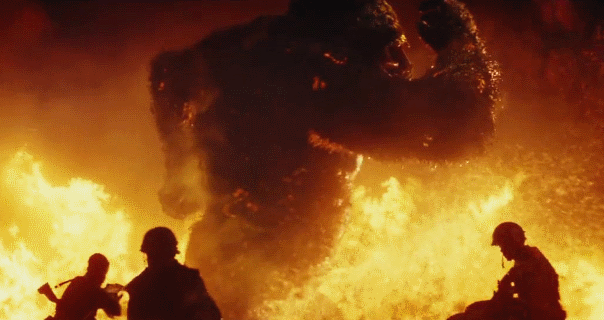
Again, whenever Vogt-Roberts is directing the monsters, and having Kong and/or the ever-ravenous Skullcrawlers dominate the screen, his direction tends to excel. Vogt-Roberts does a great job of conveying a sense of scale in Kong: Skull Island, creating a truly larger-than-life setting that truly does feel dangerous and impossible to truly conquer. Likewise, the majesty captured around Kong himself is generally done well, even at Kong’s most violent and angry. There is a fine balance between danger and beauty across Skull Island, which manages to feel like a cool setting, one that at least does a solid job of immersing audiences in the danger, thanks to how it’s presented.
That said though, Vogt-Roberts’ lack of experience with blockbusters is sometimes evident. There’s a few weirdly-framed character moments that only further highlight how bland a lot of the personalities are, most notably. Likewise, a few of the attempts at directing flourishes don’t always work, and just become distracting. There is a lot of effort put into the direction though, and at the very least, Vogt-Roberts definitely gets the monsters and atmosphere right, which is what likely counts the most in the case of Kong: Skull Island.
Another surprising highlight to Kong: Skull Island is its soundtrack, which contains a lot of Vietnam-era rock music combined with some unsettling, ambiance-heavy compositions from Henry Jackman. The clash between bruised American egos and a no-win scenario in an untamed monster landscape is realized well in the soundtrack, and regardless of your opinion of King Kong, movie enthusiasts might want to give this soundtrack a listen on its own merits, since it’s objectively pretty well done.
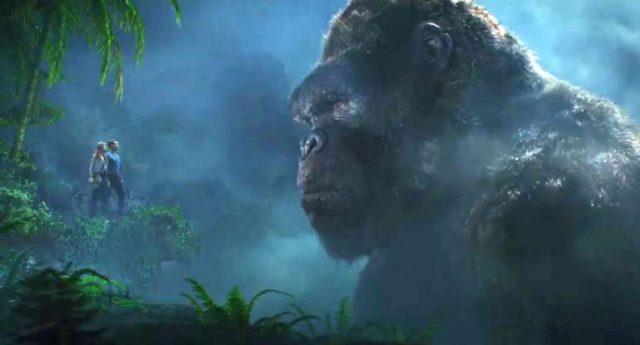
The rest of the audio work also conveys a pretty solid sense of scale, especially if you happen to be watching Kong: Skull Island in an IMAX theatre, or similar specialty format. The roars and stomps of the monsters will prove especially powerful and immersive this way, though even in a regular theatre, their sheer size and presence makes Kong: Skull Island best experienced on the big screen, rather than waiting for home viewing. Kong himself has particularly never felt larger or more mighty, so in this case, he’s definitely more in his element by actually staying out of New York!
Unsurprisingly, Kong: Skull Island is a gorgeously-realized movie for the most part. There’s a handful of unconvincing CGI effects here and there, but they’re not really worth dwelling on, especially when so much of the movie is shot on location against the gorgeous nature-filled backdrops of both Hawaii and Vietnam. Skull Island is a hostile, unpredictable landscape that manages to feel real enough, while still managing a good sense of otherworldly style. It may sometimes be evident that a few scenes are shot on a green screen, but this doesn’t become nearly evident enough to take audiences out of the experience.
The movie’s monsters almost universally look fantastic as well. Kong’s increased size generally doesn’t compromise his sense of detail, even if he does look a little less lifelike here than he did in Peter Jackson’s King Kong remake from 2005. The other monsters look especially stylized, but most of them also look nicely detailed and frightening. The Skullcrawlers are probably the height of the monster design in Kong: Skull Island though, being truly the stuff of nightmares, especially in how terrifyingly efficient they are at picking off the human characters while virtually unseen and unheard mere seconds before!
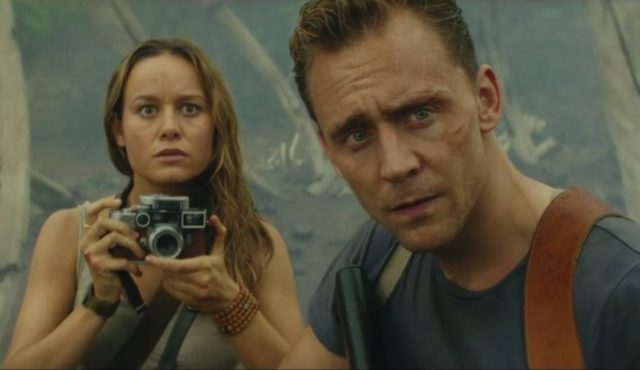
Surprisingly, the 3D presentation in Kong: Skull Island is also pretty good, adding a significant amount of boosted atmosphere and scale to the production. The 3D does occasionally become extra distracting during some of the less successful directing flourishes, though a few fun moments of cheeky 3D effects, such as debris that appears to bounce and fly toward the audience, can nonetheless be pretty entertaining to people who enjoy 3D spectacle in movies. The IMAX screen is used less effectively, which is surprising, considering that Kong: Skull Island and its massive beasts absolutely beg for a proper IMAX filming design, though the IMAX 3D cut at least still provides a pretty good audio boost to the experience. At minimum, I’d say a standard digital 3D ticket probably represents the best value for Kong: Skull Island in theatres, since the 3D work is quite well-done overall, though if you’d rather avoid some of the 3D gimmickry, the visuals still work plenty well when viewed flat in 2D.
Kong: Skull Island injects a bit more fun into Warner Bros.’, Universal’s and Legendary Pictures’ shared MonsterVerse that began with Godzilla in 2014, even though this sophomore movie is especially lacking in a real human touch. You’re definitely going to have to come for the monsters in this case, since it’s impossible to truly care about any of the humans that we’re frequently stuck with in this movie, but King Kong has certainly had worse cinematic stints, even if he’s also clearly had better ones.
If nothing else, Kong: Skull Island is a monstrous good time, and will do a decent job of continuing to get you excited for 2020’s crossover Godzilla vs. Kong movie. When stacked against last week’s emotional, dramatic powerhouse blockbuster, Logan from 20th Century Fox, Kong: Skull Island feels like an especially empty-headed, style-driven blockbuster in comparison, but it gets its title character and setting right, so it’s difficult to call the movie a disappointment, even if it’s also certainly not high art. This is very much a simple-minded popcorn flick, so those expecting another King Kong-level classic will definitely be disappointed.
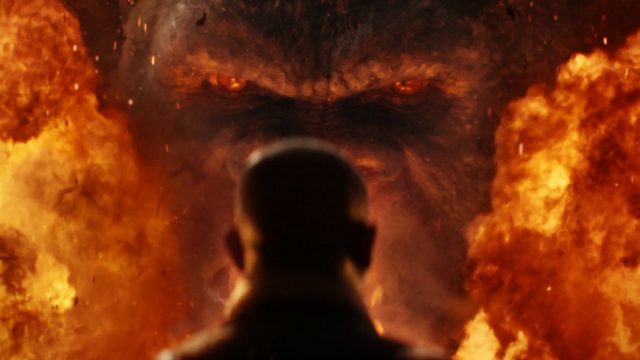
If you enjoy monster-themed movies, then Kong: Skull Island is definitely worth seeing on the big screen nonetheless, where you can get the most out of its huge scale and awe-inspiring might. There isn’t a lot here beyond the style and the appeal of a hundred-foot tall ape beating down on other larger-than-life monsters, but if that’s all you need for an enjoyable cinematic experience, then Kong: Skull Island at least delivers that. It doesn’t carry Legendary’s shared cinematic MonsterVerse to stunning new heights, but it also doesn’t make the prospect of its existence all that offensive either.

